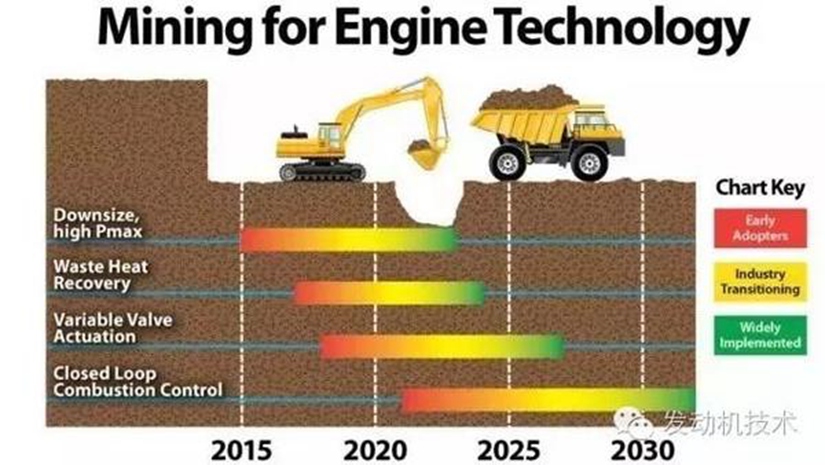In some developed countries and regions such as North America, the emission requirements for diesel engines have been upgraded to the Tier 4 standard, which is much higher than that in China. Therefore, in these areas, some technology and scientific research institutions are constantly working towards improving fuel efficiency to improve the thermal performance of diesel engines. As diesel engine manufacturers, they are constantly seeking technologies and methods to increase productivity, increase reliability and reduce operating costs, while also meeting stringent emission regulations. Currently, the thermal efficiency of diesel engines is about 40% to 45%, and the US Department of Energy (DOE) sets a target of 55%. By the end of 2020, this goal will be possible. New technologies not only improve the work of diesel engines. Efficiency, but also can be commercialized. â— Engine miniaturization Miniaturization refers to reducing the displacement of the engine, but the output power does not change. The goal of emission reduction is more than 10%, which translates into 1% to 4% increase in fuel efficiency. Smaller engines are more suitable for smaller off-highway equipment. In some equipment, deceleration control is also a possibility. In order to achieve improved efficiency. For example, if the engine speed is reduced by 200 revolutions, it may bring about 1% to 3% improvement in fuel economy. Increasing the cylinder pressure is another feasible practice, but this requires that the compression ratio of the fuel will increase simultaneously, and the strength of the cylinder head will also increase. At present, the direction of technical research has gone beyond the direction of new materials, and graphite cast iron (Compacted graphite) is a relatively new material that can provide strong pressure resistance and lighter weight. The third research direction is fuel injection and air mixing in the cylinder. Fuel pressures continue to increase, improving fuel delivery and combustion, which leads to higher performance and reduced emissions. In order to improve the combustion efficiency, the piston design in the cylinder was also put on the agenda. For example, Ricardo's Twin Vortex Combustion System (TVCS), the core of this technology is fuel injection divided into upper and lower combustion to better manage air-fuel ratio and reduce smoke and dust. This will result in lower engine emissions and better fuel efficiency. â— Waste heat recovery Waste heat conversion and waste heat recovery are another research direction. About 50% of the engine's energy is waste heat, and half of it is wasted (25% of the total energy). From this perspective, the space available for waste heat recovery is extremely large. There are two main methods for energy recovery: direct and indirect. The direct method converts waste heat into electricity by using a thermoelectric generator (TEG). TEG works on the principle that voltages are generated between different metals exposed to high temperatures, which is similar to a thermocouple producing electricity. Ultimately, the power generated by the TEG can act on the crankshaft of the engine to compensate for the power consumed by the internal mechanical transmission of the engine. If there is excess power that can be stored elsewhere. The most common indirect method is the Rankin Cycle. The principle is to use waste heat to generate steam, and then use the kinetic energy generated by steam. It is expected that by 2020, this device will increase fuel efficiency by more than 7.5%. The two biggest challenges to the commercialization of these technologies are to increase efficiency and reduce costs. At the moment, the operating cost of a thermoelectric generator is about $3,000/kW, but the target is <$1,000/kW. (Translator's Note: These are US dollars, converted to RMB 18,000/kW and 6,000/kW) The efficiency of the system also depends on the operating cycle of the engine (exhaust temperature). Despite this, technicians are still actively seeking solutions to achieve thermoelectric conversion with lower material, cost, and volume. â— Variable valve technology Variable valve actuation (VVA) is a technique similar to that used in automotive engines and is more commonly used on large diesel engines. Compared with other technologies such as the broken cylinder ratio, variable valve technology can more easily achieve greater fuel efficiency and increase torque output at low speeds. At present, this technology is being focused on. â— Closed-loop combustion control The concept of closed-loop combustion control is the real-time monitoring of the entire combustion process. This requires starting control from the fuel injection, including the strategy of fuel injection, and the adjustment of the pressure in the cylinder. Data show that closed-loop control can improve the combustion efficiency by 2%-4% compared to the traditional open-loop control. However, closed-loop control brings about an increase in the complexity of the system. This leads to stability risks. For example, the sensor must penetrate deep into the cylinder to detect pressure and temperature. It must also be able to process data quickly. This also means cost. increase. However, closed-loop control technology has proven its effectiveness on automotive engines. Therefore, in the future, heavy-duty diesel engine technology is bound to be a direction that cannot be bypassed. These technologies are only a series of technologies that have been created under the increasingly stringent emission regulations. In the future, we believe that the global emission requirements will become increasingly stringent. Whenever the combustion efficiency of diesel engines is a technical direction, they are In the near future, the combustion efficiency of diesel engines will be higher and higher. Coconut Shell Based Powdered Activated Carbon Coconut Shell Based Powdered Activated Carbon,Powder Activated Carbon,Activated Coconut Carbon,Coal Based Powder Activated Carbon Shanxi Xinhui Activated Carbon Co.,Ltd. , https://www.shanxixinhuicarbon.com